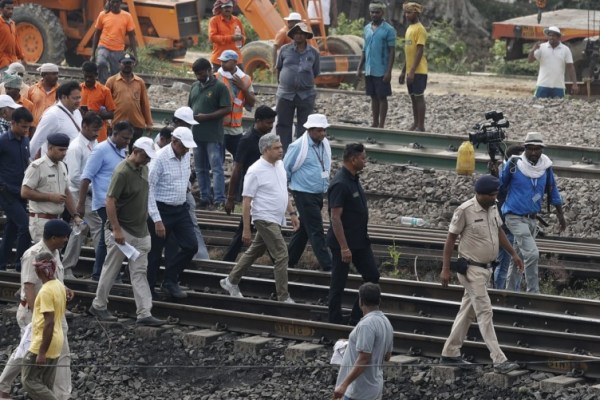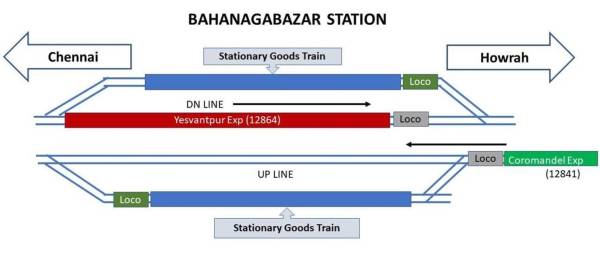'Root cause identified': What Railway minister Vaishnaw has said ...
The Railways identified the “root cause” of the accident in Odisha on Friday (June 2) evening, the death toll from which has now reached 275. Union Railway Minister Ashwini Vaishnaw has indicated that “someone” made a change “to the point machine, the configuration of the track”, resulting in the collision.

It was not clear from the Minister’s statement whether this human involvement was the result of what is called a “human error”, or whether there was a possibility of deliberate action or sabotage.
Earlier, the Railways had issued a sketchy official statement on the tragedy near Bahanaga Bazar station, with very few details. While the full picture will be clear only after an official inquiry into the incident, a more detailed official statement from the Railways continues to be awaited.
Union Railway minister Ashwini Vaishnaw overseeing the restoration work at the accident spot in Balanaga village in Odisha’s Balasore district. (Express photo by Partha Paul)
This is what we know about the crash so far, based on the information provided by sources in the Railways, and the statements made by Vaishnaw.
First of all, what has the Minister said?
Railway Minister Ashwini Vaishnaw on Sunday (June 4) said: “The root cause (of the accident) has been identified. And the people who have done it have also been identified.”
He said the Commissioner of Railway Safety report would be made public soon. “Kis karan se yeh haadsa kiya gaya, usski bhi jaankari jald hi samne aa jayegi (The CRS inquiry report – the reason why the accident happened will also be known),” he told DD News.
Does this mean there was sabotage?
That is not clear as yet. The Minister was asked if anti-social elements were involved, but he declined to commit to an answer.
“To say something on that right now would be possible but not proper before the report of the CRS probe,” he said.
OK, to recall, where and when did this accident happen?
The spot of the crash is a little before Bahanaga Bazar station in Odisha’s Balasore district, which is part of the Kharagpur railway division of the South Eastern Railway. Three trains were involved — two passenger trains going in opposite directions, and a goods train that was stationary.
Illustration of the spot where the accident took place in Odisha.
The first train, the 12841 Coromandel Express, had started from Shalimar station in Kolkata/Howrah and was headed to Chennai. It had crossed Kharagpur and Balasore, and its next stop would have been Bhadrak. The train was running almost exactly on time, and would have gone past Bahanaga Bazar (without stopping) at 7.01 pm.

There is the Up Main Line (towards Chennai), the Down Main line (towards Howrah), and two loop lines on the two sides. The purpose of a loop is to park a train on the side so that the main line is left clear for a faster or more important train.
As the Coromandel approached, the loop line was occupied by a goods train going in the same (Up) direction. The Coromandel was supposed to go past it on the main line.
So what went wrong here?
According to the short brief on the accident issued by the Railways on Saturday (June 3), “Up Train No. 12841…passing through Up Main Line…dashed with stationary Goods Train in Up Loop Line… The train was going at full speed across the station as it was not supposed to stop at the station…”
It was obvious from the brief that the Coromandel, instead of going past the goods train on the main line, entered the loop and smashed into the goods train from the rear. Pictures from the spot showed the Coromandel’s locomotive perched atop the goods train.
But how could that happen?
Locomotive drivers are guided by signals, not so much by what they see on the tracks, especially in the dark. The Railways have been looking at the possibility of a signalling error since Saturday.
A multi-disciplinary joint inspection by supervisors had concluded that a green signal was given to the Coromandel to pass through on the designated main line, and then the signal was taken off. The train entered the loop line, and rammed into the goods train.
“We…after careful observation, came to the conclusion that signal was given, and taken off, for Up main line for 12841, but this train entered into Up loop line and dashed with goods train which was on Up loop line and derailed,” said a note prepared by the joint inspection team on Saturday.
So how does this tie up with what Vaishnaw has said now?
Vaishnaw essentially said someone had changed the configuration of the signalling (point) on the track, which led to the Coromandel to enter the loop line.
“Whoever has done it, has done such a change to the point machine, the configuration of the track, which enables everything to function together, has been changed and that is why the accident has happened,” he said. “But I will say everything after CRS report comes out.”
What is the basis of this conclusion?
Top officials have concluded that unless tinkered with, the “core logic” of the signalling system would ideally not allow an isolated signal to turn green for one line while at the same time the physical “point” of the track directs the train to another line.
Checks and balances are hardcoded in the logic of the signalling system that errs on the side of caution, they said.
Could the driver have done something to prevent the crash?
Trains are gigantic masses of steel, hauled by enormously powerful engines. The railway brief says the Coromandel was going at “full speed”, which could be around 100 km/hr. At that speed, even after the application of emergency brakes, a train would not come to a halt before perhaps a couple of kilometres.
So where does the third train come into the picture?
At the same time as the Coromandel hit the goods train, a third train, the 12864 Yesvantpur-Howrah Express, was going past on the adjacent Down main line, headed towards Howrah (in the opposite direction). Most of this train had already crossed the point of the accident when the Coromandel crashed into the goods train. However, the last few coaches were impacted. These derailed — either because they were hit by coaches of the Coromandel that toppled onto them, or because of the shock waves that could have passed through the ground and the tracks.




































































